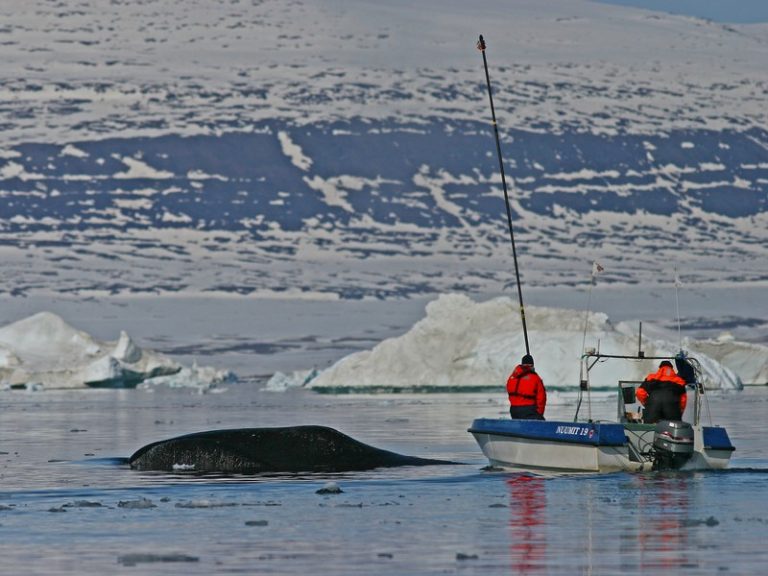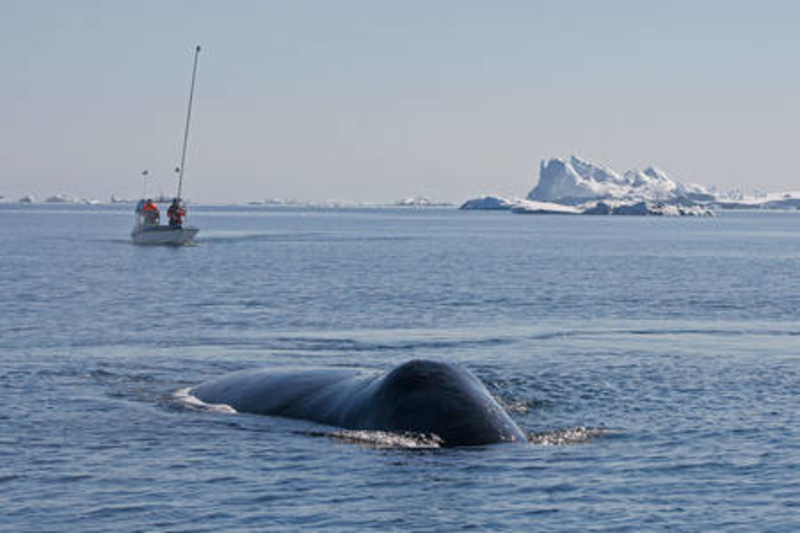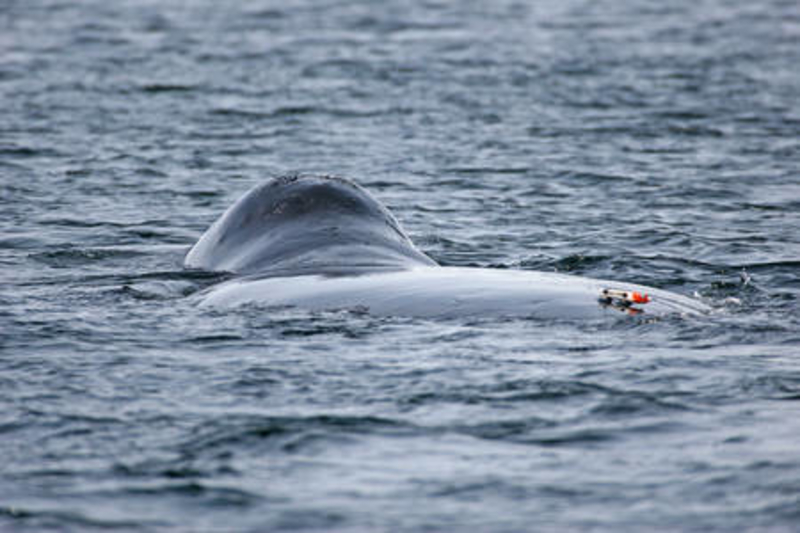Bowhead whale hunts in slowmotion Published 02.09.2009

New research from Aarhus University and the Greenland Institute of Natural Resources shows that one of the largest predators in the world, the bowhead whale – also known as the Greenland right whale or Arctic whale – hunts in slow motion to catch billions of small animal plankton. In spite of its slow swimming speed of 2.5 kilometers per hour, a bowhead whale can filter 80,000 tonnes of water per day, corresponding to the water consumption of 2,000 Danes per year.
The new results have just been published in the internationally renowned scientific journal Proceedings of the Royal Society.
Biology of the bowhead whale
The bowhead whale is the only baleen whale that spends its entire life in the Arctic waters. Although its weight of up to 70 tons makes it one of the three heaviest animals in the world, it mainly lives on very small water fleas that are less than 5 millimeters in length. In order to catch these small creatures, the bowhead whale has hundreds of closely spaced baleen plates that measure up to four metres in length and form the largest living sieve in the world.
The bowhead whale’s problem
When baleen whales sieve their food out of the water, these otherwise streamlined animals create enormous water resistance with their open mouths. Such great resistance requires considerable energy when swimming, and the whales thus use up their oxygen reserves very quickly. As whales need to come up to the surface to breathe when their oxygen deposits have been used up, the baleen whales generally dive for a very short time when they are foraging.
The head and filtration apparatus account for one third of the entire bowhead whale, which differs from other baleen whales by making very long dives. How these giants could remain submerged for such a long time while presumably swimming at high speed against enormous water resistance has always been a mystery. In an attempt to unveil the foraging habits of one of the largest animals in the world, PhD student Malene Simon and her supervisor Associate Professor Peter T. Madsen attached small computers with measuring equipment to bowhead whales while they were foraging in Disko Bay, West Greenland, in international collaboration with researchers from the Woods Hole Oceanographic Institution in the USA.
Entire hunt in slow motion
Measuring equipment the size of a hand was temporarily attached to the whales’ backs (see photo 3) using suction caps. The device has a number of advanced technology sensors that record details of the whales’ movements and depth.
“Air-breathing aquatic animals have to save on their oxygen reserves when they’re catching prey in the depths of the ocean. They normally do this by taking a break in their fluking rates, so that they glide through the water and thereby save energy,” says Malene Simon, PhD student at Aarhus University and the Greenland Institute of Natural Resources.
As opposed to other aquatic mammals, bowhead whales use their tails constantly when swimming in order to counteract the enormous resistance from their open mouths when eating. When swimming at a normal speed, this would result in significant oxygen consumption for other whales, but the researchers have now shown that by fluking slowly, but continuously, the bowhead whales can swim forwards in slow motion at approximately 2.5 kilometers per hour and thus save oxygen. This means that the whales slowly swim forwards at a speed that is approximately one third of that of other whales when foraging, so that they are capable of propelling the enormous filtration apparatus in the most economical way.
“We’re actually dealing with one of the largest predators in the world, which paradoxically catches its prey by moving very slowly. The bowhead whales have developed this highly specialised swimming behavior to be able to utilize the large swarms of Arctic water fleas, which are not fast enough to dodge a huge predator in slow motion,” continues Malene Simon. “It’s obvious that for such large animals to be able to live on planktonic water fleas, they have to filter enormous quantities of water. Our results also show that in spite of everything taking place in slow motion, a bowhead whale filters more than 80,000 tons of water a day. To put this in an everyday perspective, it corresponds to the household water consumption of 2,000 Danes for a whole year!”
The research results make up part of Malene Simon’s PhD studies, sponsored by the Oticon Foundation. The purpose is to study the acoustics and foraging habits of baleen whales in West Greenland.
- A bowhead whale on the surface, drawing breath after a long dive foraging for food. In the background is a small dinghy with Abel Brandt, a local hunter, and biologist Peter T. Madsen. They are approaching the whale with an eight-metre-long carbon fibre rod used to attach a computer with measuring equipment. Photo: Malene Simon.
- The five-metre-wide tail of a bowhead whale as it dives to forage for food in the cold, nutrient-rich water south of the island of Disko off the west coast of Greenland. Photo: Malene Simon.
- A bowhead whale on the surface, drawing breath between two dives foraging for food. On the right side of the whale, the researchers have used suction caps to attach the 20 cm long computer with measuring equipment that has provided fundamental new knowledge about the way in which one of the largest predators in the world catches billions of microscopic zooplankton. Photo: Malene Simon,




